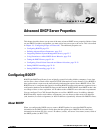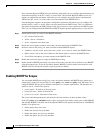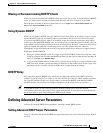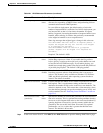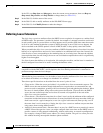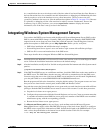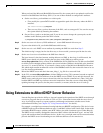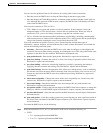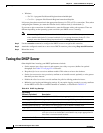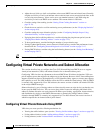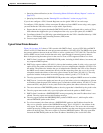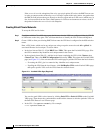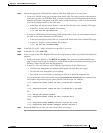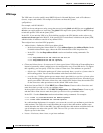
22-6
Cisco CNS Network Registrar User’s Guide
OL-6240-02
Chapter 22 Advanced DHCP Server Properties
Defining Advanced Server Parameters
In the CLI, use dhcp show and dhcp get to show the current server parameters, then use dhcp set,
dhcp unset, dhcp enable, and dhcp disable to change them (see Table 22-1).
Step 2 In the Web UI, click the name of the server.
Step 3 In the Web UI, add or modify attributes on the Edit DHCP Server page.
Step 4 In the Web UI, click Modify Server to make the changes.
Deferring Lease Extensions
The defer-lease-extensions attribute allows the DHCP server to optimize its response to a sudden flood
of DHCP traffic. The parameter is enabled by default. An example of a network event that could result
in such a traffic spike is a power failure at a cable internet service provider (ISP) data center that results
in all of its cable modem termination systems (CMTS) rebooting at once. If this were to happen, the
devices attached to the CMTSs produce a flood of DHCP traffic as they quickly come back online.
When you enable the defer-lease-extensions attribute, a DHCP client that renews a lease that is less than
halfway to its expiration does not have its lease extended to an additional full lease time. Instead, the
client receives a lease corresponding to the remaining time on its existing lease. Because the absolute
lease expiration time does not change, the server can avoid database updates that result in a significantly
higher server throughput.
If a client is more than halfway to its expiration, this setting has no effect, and the lease is extended to
the full configured lease interval as usual, including the database writes.
Note Deferring lease extensions significantly increases the server’s performance while remaining in
compliance with the DHCP RFC, which stipulates that client binding information is committed to
persistent storage when the lease changes.
When deferring lease extensions, it is advisable to leave the policy attribute allow-lease-time-override
to its default of disabled, or to change it to disabled if it is enabled.
These three specific situations are described from the server’s point of view:
• Client retries—When the server gets behind, it is possible for a client to retransmit requests. The
DHCP server does not maintain enough information to recognize these as retransmissions, and
processes each to completion, granting a full lease duration again and updating the database. When
the server is already behind, doing extra work worsens the situation. To prevent this, the DHCP
server does not extend leases that are less than 30 seconds old, regardless of the state of the
defer-lease-extensions attribute.
• Client reboots—The effective renew time for a client’s lease is really the minimum of the configured
renew time and the time between client reboots. In many installations this may mean that clients get
fresh leases one (in a typical enterprise) or two (in a typical cable network) times per day, even if
the renew time is set for many days. Setting the defer-lease-extensions attribute can prevent these
early renews from causing database traffic.
• Artificially short renewal times—Because there is no way for a DHCP server to proactively contact
a DHCP client with regard to a lease, you might configure short lease times on the DHCP server to
provide a means of doing network renumbering, address reallocation, or network reconfiguration
(for example, a change in DNS server address) in a timely fashion. The goal is to allow you to do
this without incurring unacceptable database update overhead.



